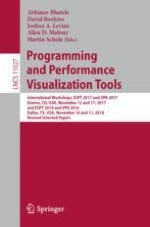This book contains the revised selected papers of 4 workshops held in conjunction with the International Conference on High Performance Computing, Networking, Storage and Analysis (SC) in November 2017 in Denver, CO, USA, and in November 2018 in Dallas, TX, USA: the 6th and 7th International Workshop on Extreme-Scale Programming Tools, ESPT 2017 and ESPT 2018, and the 4th and 5th International Workshop on Visual Performance Analysis, VPA 2017 and VPA 2018.
The 11 full papers of ESPT 2017 and ESPT 2018 and the 6 full papers of VPA 2017 and VPA 2018 were carefully reviewed and selected for inclusion in this book. The papers discuss the requirements for exascale-enabled tools as well as new approaches of applying visualization and visual analytic techniques to large-scale applications. Topics of interest include: programming tools; methodologies for performance engineering; tool technologies for extreme-scale challenges (e.g., scalability, resilience, power); tool support for accelerated architectures and large-scale multi-cores; tool infrastructures and environments; evolving/future application requirements for programming tools and technologies; application developer experiences with programming and performance tools; scalable displays of performance data; case studies demonstrating the use of performance visualization in practice; data models to enable scalable visualization; graph representation of unstructured performance data; presentation of high-dimensional data; visual correlations between multiple data sources; human-computer interfaces for exploring performance data; and multi-scale representations of performance data for visual exploration.
